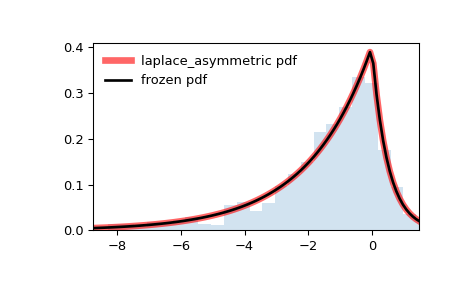scipy.stats.laplace_asymmetric#
- scipy.stats.laplace_asymmetric = <scipy.stats._continuous_distns.laplace_asymmetric_gen object>[source]#
An asymmetric Laplace continuous random variable.
As an instance of the
rv_continuousclass,laplace_asymmetricobject inherits from it a collection of generic methods (see below for the full list), and completes them with details specific for this particular distribution.See also
laplaceLaplace distribution
Notes
The probability density function for
laplace_asymmetricis\[\begin{split}f(x, \kappa) &= \frac{1}{\kappa+\kappa^{-1}}\exp(-x\kappa),\quad x\ge0\\ &= \frac{1}{\kappa+\kappa^{-1}}\exp(x/\kappa),\quad x<0\\\end{split}\]for \(-\infty < x < \infty\), \(\kappa > 0\).
laplace_asymmetrictakeskappaas a shape parameter for \(\kappa\). For \(\kappa = 1\), it is identical to a Laplace distribution.The probability density above is defined in the “standardized” form. To shift and/or scale the distribution use the
locandscaleparameters. Specifically,laplace_asymmetric.pdf(x, kappa, loc, scale)is identically equivalent tolaplace_asymmetric.pdf(y, kappa) / scalewithy = (x - loc) / scale. Note that shifting the location of a distribution does not make it a “noncentral” distribution; noncentral generalizations of some distributions are available in separate classes.Note that the scale parameter of some references is the reciprocal of SciPy’s
scale. For example, \(\lambda = 1/2\) in the parameterization of [1] is equivalent toscale = 2withlaplace_asymmetric.References
[1]“Asymmetric Laplace distribution”, Wikipedia https://en.wikipedia.org/wiki/Asymmetric_Laplace_distribution
[2]Kozubowski TJ and Podgórski K. A Multivariate and Asymmetric Generalization of Laplace Distribution, Computational Statistics 15, 531–540 (2000). DOI:10.1007/PL00022717
Examples
>>> import numpy as np >>> from scipy.stats import laplace_asymmetric >>> import matplotlib.pyplot as plt >>> fig, ax = plt.subplots(1, 1)
Calculate the first four moments:
>>> kappa = 2 >>> mean, var, skew, kurt = laplace_asymmetric.stats(kappa, moments='mvsk')
Display the probability density function (
pdf):>>> x = np.linspace(laplace_asymmetric.ppf(0.01, kappa), ... laplace_asymmetric.ppf(0.99, kappa), 100) >>> ax.plot(x, laplace_asymmetric.pdf(x, kappa), ... 'r-', lw=5, alpha=0.6, label='laplace_asymmetric pdf')
Alternatively, the distribution object can be called (as a function) to fix the shape, location and scale parameters. This returns a “frozen” RV object holding the given parameters fixed.
Freeze the distribution and display the frozen
pdf:>>> rv = laplace_asymmetric(kappa) >>> ax.plot(x, rv.pdf(x), 'k-', lw=2, label='frozen pdf')
Check accuracy of
cdfandppf:>>> vals = laplace_asymmetric.ppf([0.001, 0.5, 0.999], kappa) >>> np.allclose([0.001, 0.5, 0.999], laplace_asymmetric.cdf(vals, kappa)) True
Generate random numbers:
>>> r = laplace_asymmetric.rvs(kappa, size=1000)
And compare the histogram:
>>> ax.hist(r, density=True, bins='auto', histtype='stepfilled', alpha=0.2) >>> ax.set_xlim([x[0], x[-1]]) >>> ax.legend(loc='best', frameon=False) >>> plt.show()

Methods
rvs(kappa, loc=0, scale=1, size=1, random_state=None)
Random variates.
pdf(x, kappa, loc=0, scale=1)
Probability density function.
logpdf(x, kappa, loc=0, scale=1)
Log of the probability density function.
cdf(x, kappa, loc=0, scale=1)
Cumulative distribution function.
logcdf(x, kappa, loc=0, scale=1)
Log of the cumulative distribution function.
sf(x, kappa, loc=0, scale=1)
Survival function (also defined as
1 - cdf, but sf is sometimes more accurate).logsf(x, kappa, loc=0, scale=1)
Log of the survival function.
ppf(q, kappa, loc=0, scale=1)
Percent point function (inverse of
cdf— percentiles).isf(q, kappa, loc=0, scale=1)
Inverse survival function (inverse of
sf).moment(order, kappa, loc=0, scale=1)
Non-central moment of the specified order.
stats(kappa, loc=0, scale=1, moments=’mv’)
Mean(‘m’), variance(‘v’), skew(‘s’), and/or kurtosis(‘k’).
entropy(kappa, loc=0, scale=1)
(Differential) entropy of the RV.
fit(data)
Parameter estimates for generic data. See scipy.stats.rv_continuous.fit for detailed documentation of the keyword arguments.
expect(func, args=(kappa,), loc=0, scale=1, lb=None, ub=None, conditional=False, **kwds)
Expected value of a function (of one argument) with respect to the distribution.
median(kappa, loc=0, scale=1)
Median of the distribution.
mean(kappa, loc=0, scale=1)
Mean of the distribution.
var(kappa, loc=0, scale=1)
Variance of the distribution.
std(kappa, loc=0, scale=1)
Standard deviation of the distribution.
interval(confidence, kappa, loc=0, scale=1)
Confidence interval with equal areas around the median.